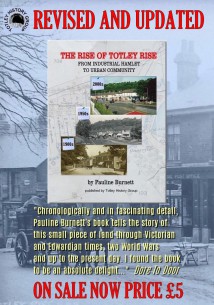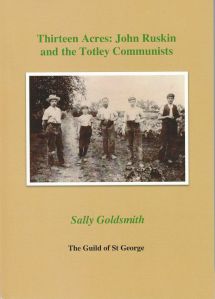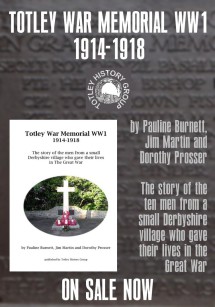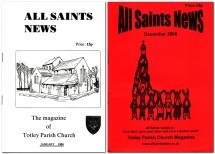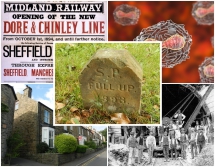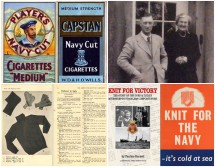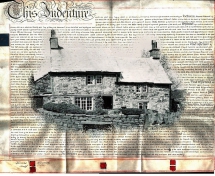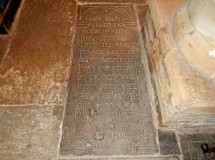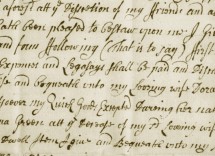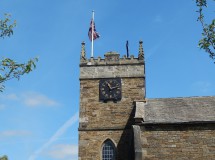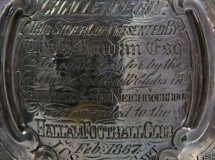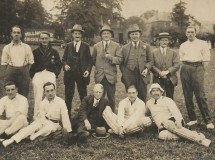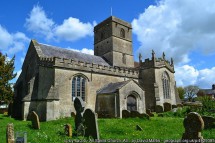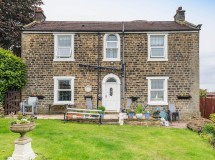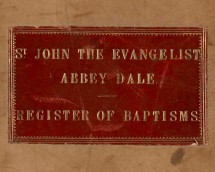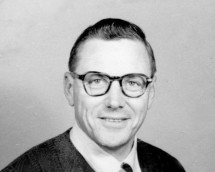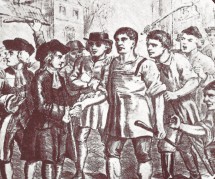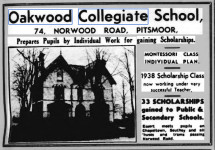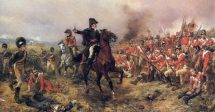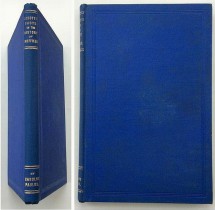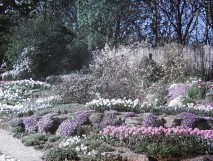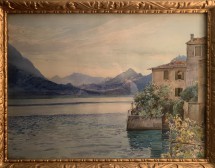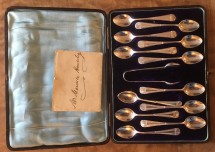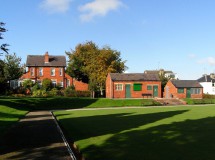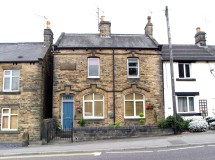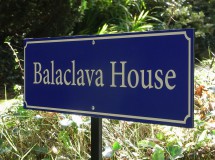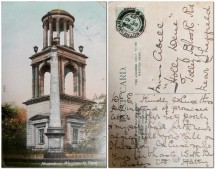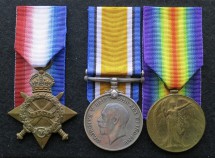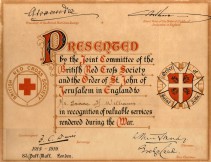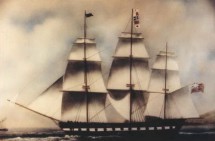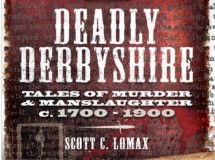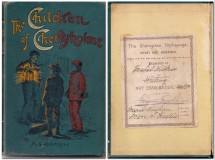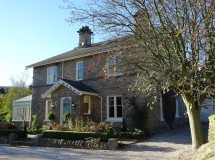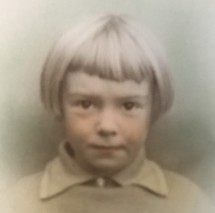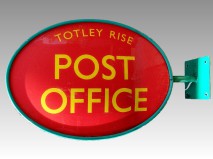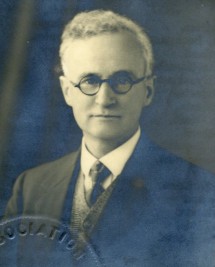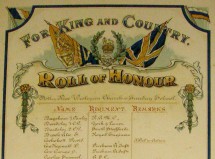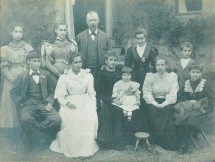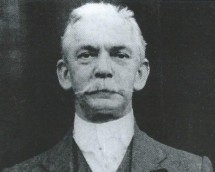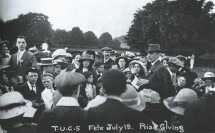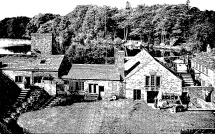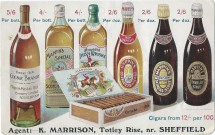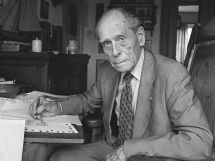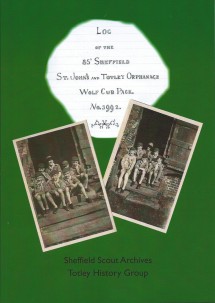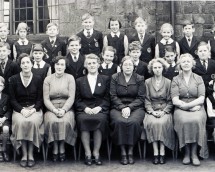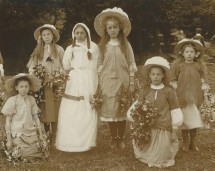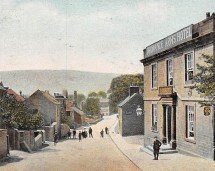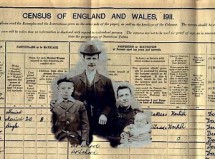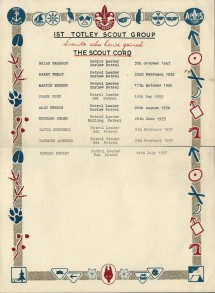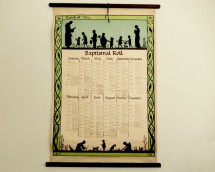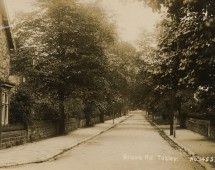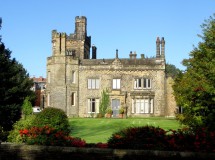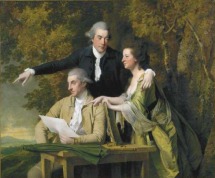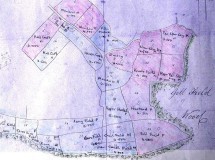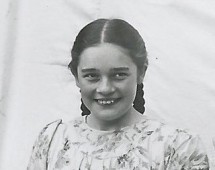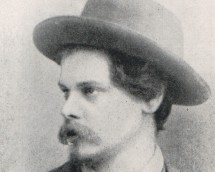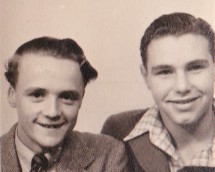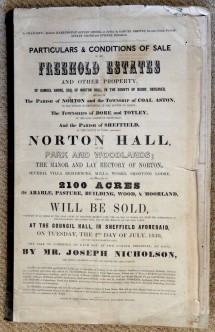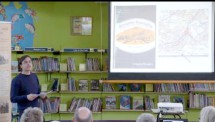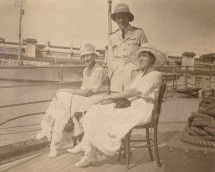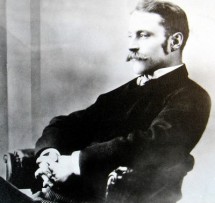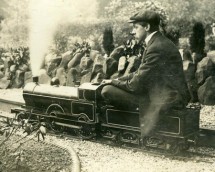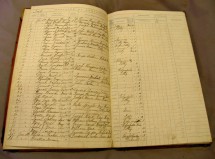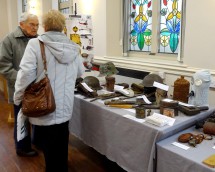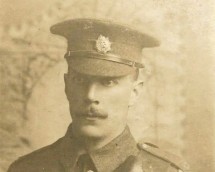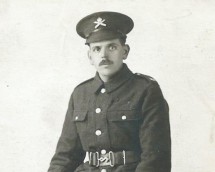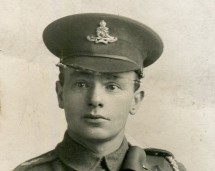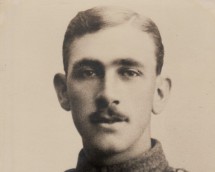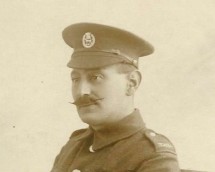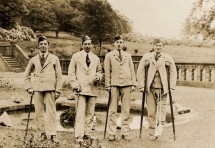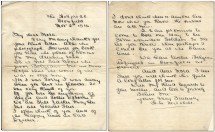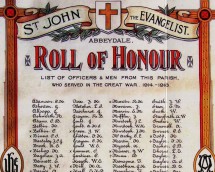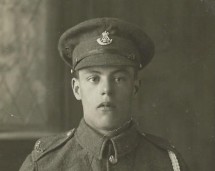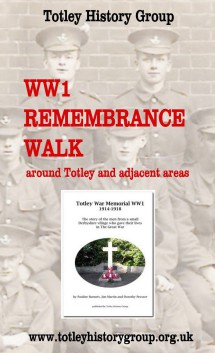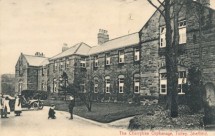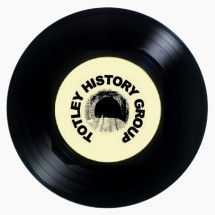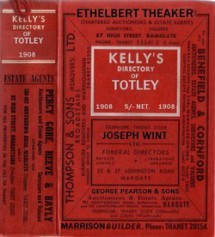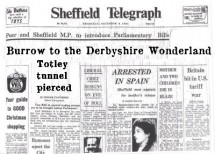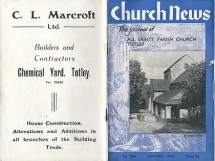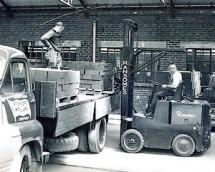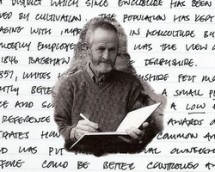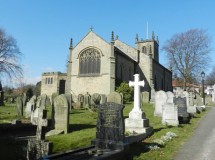Memories of Archie Herbert Thomas (1903-1991)
My paternal grandfather was the bastard son of Lord Rodney, (6th baron) and Miss Gwyneth Thomas. His lordship was one of the great gamblers of that era.
He was a most generous man and must have loved my grandfather very much as he gave him a public school education at Stow. My great nephew, Paul Joseph Thomas, is at boarding school using the same tin trunk that his great great grandfather used.
Lord Rodney then apprenticed my grandfather to a carpenter. On my grandfather coming of age he was given an estate consisting of a farm, and a mill at Brampton Brian, on the border of Hertfordshire and Powys, between Knighton and Leintwardine but, like his father, he gambled and frittered it away and returned to the comfort of my grandmother, Anne Davis, who had born a child by him some 4 years previously in 1873 - my father! They married and my grandfather was set up as a carpenter in the village of Eye, which was within the Berrington estate, the home of the Rodneys, about 4 miles of Leominster.
Like all good craftsmen he loved the wood he worked. As well as Berrington work which was put his way, he did outside work. In my youth I was proud to visit the church at Richard's Castle, near Ludlow, where did the whole of the woodwork. After the marriage of my grandparents my father's name was changed from his mother's maiden name of Davis, to Thomas. In all my grandparents had 7 surviving children. I was their first grandchild.
My grandfather died in 1912 aged 59.
My grandmother lived to be 98. Unfortunately, during the last war she fell and broke her hip. The local doctor committed a grave error. He was of the opinion that she was too old for the bone to knit and placed it between sandbags. It knit, but in the wrong position, and after lying like that for exactly 12 months, she died.
I knew nothing regarding my ancestry until my wife was past child bearing age, when my aunts (both of whom lived into their 90s) disclosed the matter to my brother and his wife, who had a son - Joseph Glyn. They also gave them a family seal of the Rodneys. How that was acquired we shall never know.
My nephew, Glyn, was Senior Fellow, Biology at Lancaster University, but now as a farm on the edge of the Lake District. His wife is the Ombudsman for the area of The Wash to the Scottish Border, and is very often mentioned in the local press, having mediated in some local dispute.
I understand that my father started work at 12 years of age, and was placed in the racing stables at Berrington. During that period, the 7th Baron had a horse entered for the St Leger at Doncaster.
Everyone on the estate was paid up and given notice and also a sovereign to wager on the horse. When my father told me of this I commented "that would be a nice little pick-up in those days, dad", he replied "well I only put half a sovereign on". The horse lost 7 lengths at the start but still won the race.
Around this period my father was thrown from a racing stallion and received a badly injured shoulder, so on his recovery his lordship took him for his personal groom and valet and, later, he was his man servant in London. His lordship occupied one floor of a 4 storey house in Belgravia, each floor of which was occupied by a batchelor Earl, so my father saw some life!
When the 7th Lord Rodney was 34 years of age he married Miss Corisande Evelyn Vere, and a son was born to them the same year.
For their honeymoon the couple toured Scotland with a carriage and pair, coachman and groom, and my father and a lady's maid followed with a pantechnican and coachman, drawn by 2 horses with all the luggage. The retainers, however, did not visit all the beauty spots that Lord and Lady Rodney visited but proceeded to the next place where accommodation had been arranged in order to prepare for the arrival of the couple.
I have no knowledge of the date that my father the service of the Rodneys, but later, he and my mother went to work for a family residing in Sloane Square and, presumably, that's where I was born as my birth certificate, issued in the sub division of Belgravia 10 November 1903, lists my father's Rank or Profession as Butler (Domestic).
In 1904 my father obtained the post of Butler to Mr William Aldam Milner of Totley Hall, Derbyshire (Aldam Road is named after Mr Milner). The head gardener Mr David Lewis was engaged the same week and this was the commencement of a lifetime's friendship. Mr Lewis subsequently became Superintendent of the Totley Sunday School for 40 years. He was a batchelor when he first came to Totley and his sister kept house for him at the house in Hall Lane, next to Toft House.
My maternal grandfather was herdsman to Sir Walter Gilbey, the wine merchant, and a great authority on equestrian matters. I well remember the room of my grandparents' cottage with a large glass case on one wall crammed with rosettes, prizes won for showing Sir Walter's cattle.
My grandfather later became manager for a gentleman farmer at South House Farm, Little Hallingbury, near Bishops Stortford. We had some lovely holidays there. We usually went to our respective grandparents for a month on alternate years and my father would join us for the last fortnight.
Later, my grandfather farmed the land which Stanstead Airport now stands.
My first recollections of Totley were when I was just under 2 years of age. On the birth of my brother Ernest I was "farmed out" to Mr Lewis's sister. I remember standing below the cupboard doors where she kept the sweets. I am told I was there for about 3 months "Auntie Poppy" did not want to part with me. I had shoulder length curls up to the age of 5 (Maurice Pearson, who was in the same class at school, must have worn his until he was 6 or 7 years old!).
When I was 11 to 13 years old I used to deliver telegrams. The Post Office at that time was at the corner of Baslow Road and Hillfoot Road and their garden came up to our front yard. Mrs Bradley was the Post Mistress and her husband a gardener-cum- keeper at the Hall. At that time Totley was the nearest telephone to Holmesfield and the Cordwell Valley.
There was an early socialist writer, Edward Carpenter, who lived in Cordwell at the time and was my favourite customer. He used to give me 6pence and a glass of lemonade. There always seemed to be someone at the house, walking around in dressing gown and sandals. It wasn't until I was in my 50s when I read a book on his live that I learnt he was a homosexual.
During the 1st World War there was always a battalion of soldiers at the Totley Rifle Range, which was another source of income to Bill Crooks and I. We spent a lot of time at the camp in our boy scouts uniforms, running to Totley Post Office for stamps, or the Top Shop for toffees etc.
At weekends we were on duty at St John's Abbeydale where the Church Sunday School had been turned into a hospital. Weeks before any wounded arrived we had been released from school some afternoons to go to the Masonic Hall at Dore Station for the ladies of the district (who were going to "man" the hospital) to practice bed changing whilst the patient was still in bed, bandaging arms and legs etc.
I attended Totley Church of England School, Hillfoot Road, where I met my future wife Doris Bradbury. My best pal at school was Edgar Gill and in the summer holidays I practically lived at his home at Old Hay. Three of us slept in a small patrol tent. It never seemed to rain in those days! The dam was still there, although the water wheel had been removed. Charlie Coates lived nearby. He was an excellent skater and used to spent hours and hours on the dam when it was frozen over.
In our early childhood our playground was in the croft in front of the lodge in Hall Lane. John and Arthur Holding and my brother and I used to team up oldest and youngest - that
was John and Ern against Arthur and I. We were privileged children, our fathers being in the service at the Hall. We went into the wood and pinched raisins from "Old Bradley's
Hut" that was there to feed the pheasants, forbidden ground to any other children of the village.
There was always a large Christmas Party at the Hall when the family waited on the servants. All the neighbouring farm families were there as a little sop for the hunting and shooting over the land they farmed. Our Christmas parties were at Hall Lodge, our house, or Ash Cottage. Mary Holding was the star turn; she had the ability to recite the poetry we had learned at school, and could continue to entertain by making up a story as she went along. Mary still lives at Ash Cottage. She is the aunt of a well-known Totley sportsman - David Holding.
In the bottom cottage in the 3 on Baslow Road lived Mrs Fisher. To my brother and I there was no-one like her in the world, she had 3 sons at home and the youngest daughter, Jess; 3 other daughters being out in service. Jess later became Mrs Joshua Tyzack - an affair of which I probably have more knowledge than any other living person! I loved the youngest son, Tom, and one of my earliest recollections of him (when I was about 3 years old) is of him taking me by the hand one dark winters evening and going to Ash Cottage where he milked a couple of cows for an elderly Mr and Mrs Hattersley. When he took the milk to the house he was given about a half-gallon can of morning milk for his mother. I used to go with him when he was mowing and sit on his knees on the machine for hours at a time, while he mowed the land where Main Avenue, Rowan Tree Dell and all that property now stands.
As schoolboys we had a glorious life. We roamed Totley Moss, Blackamoor, Fishers Moor to Strawberry Lee to Fox House. Blacka was a favourite spot for at that time there was a densely wooded area from the end of Short Lane where you entered a dark wood. Our favourite "ducking hole" was the old sheep wash in Bull Wood - that is the small wood between the bottom of Gillfield Wood and the field that backs onto the houses of Rowan Tree Dell.
There was another good pool in the Cricket Wood, made by Caprons of Greenoak House, and further improved by the sons of Pearsons of St Georges Farm. The pool made by Milners in Gillfield was too cold - it got full of dead leaves - but was cleared by the lads of the village around 1932, the main worker being Fred Hoole.
As schoolboys we were all in the choir, the services then being held in the school at Hillfoot Road. The school lent itself to this use at the classroom, with the large doors at the end of the big room was used as a vestry. The preacher was Captain Nicholls. Later preachers were Captain Fogarty of the Church Army and of course Mr A J Foulstone, a great man of boundless energy who did more for Totley than any other person before or since. He took us camping, and cooked breakfast for all of us. He had a bible class every Sunday morning. There was a "reading room" (as it was called in those days) which had 2 quarter sized billiard tables. When the reading room became defunct, one of the tables went to the Gill brothers and the other to Bill, Percy and Victor Crooks. Under the guidance of Mr A J Foulstone this club, the Cricket Club and the football club were merged about 1921 and became the Totley Sports and Social Club with a club room in what had been a British Legion Club in Hillfoot Road. It had 2 full sized billiard tables, 2 cricket teams, 2 football teams and a library of over 1,000 books with every bound edition of Punch from the first issue. I was Honorary Secretary for almost 15 years. We have had dances in the Labour Hall (now the Conservative Club!) and have taken £14 at the door at 1/- a time. Totley Club could have purchased that building for £1,000 but we missed our chance.
As mentioned earlier we were all in the choir but far from "little angels" - we did the most daring apples scrumping - Tom Wright and my brother Ern always last there but first back!
Our most serious escapade was one Sunday afternoon at the start of the building of the Heatherfield Estate. One of the first things the contractors did was to put down a light railway with small trucks to push material around. 4 of these trucks were chocked up at the top of a gradient that ran from about where the corner of Terry Road and The Grove now cross. We pulled the chocks out for a ride, but things got out of hand and the 4 trucks raced down the line towards the wood, through the wall, and down the wood into the stream below.
It was Constable Bagshawe who at that time always started investigations into what he called "the usual trio" - Thomas, Gill and Pearson (Willis).
One winter's evening Edgar Gill, Tom Reynolds and I went to Dore and congregated with the Dore lads at the corner of the Vicarage Lane and Savage Lane where there was a gas lamp. An argument broke out and then a fight. It was Dore v Totley, and we 3 were getting the worst of it. Then "sharp Alex" (me) pulled up a grass sod that was growing between the bottom of the wall and stone pavement and put it through the gas lamp. Everybody scarpered; we didn't' stop running until we got to Totley. The next day the Dore Constable was at our house. Fortunately, my father was at home. I think it was the fact that he was butler to the local JP that saved our bacon that time!
(There was another occasion - later in life - where the same applied. I had had to work the Sunday on a new service at Atkinsons Steel Works behind their Moor shop and had arranged not to meet Dot from Church; so Frank Taylor, Edgar Gill and I went for a Sunday evening stroll intending to go to The Robin Hood for a drink. (Beer was then 5p a pint!). When we got to the end of Moorwoods Lane we slipped the dog under the gate and nonchalantly walked up the hill When we reached the corner of Fanshawe Gate Lane, the Keeper for Wilsons, Henry Helliwell, and the chauffeur Idra Parr, were waiting with guns under their arm. They were out for an evening's shooting. Of course, we said that the dog had gone on his own accord. Frank and they got into a heated argument then who should come around the corner but the constable from Holmesfield - Birch. I think we would have got away with it but Frank Taylor poked Constable Birch in the chest saying "Don't thee come here calling me a poacher, Birch". That did it! Names, addresses, age, occupation etc. We didn't go to The Robin Hood. Now Mrs Wilson, before her marriage, was Miss Marjorie Milner so, once again dad was instrumental in getting us off the hook.)
I left Totley Church of England School at 13 years of age and commenced work at Totley Hall as stable boy - black boots, leggings, and britches. My duties consisted of caring for 2 retired hunters, one a bay gelding and another a beautiful dapple grey mare named Nipper and Polly. Feeding and watering, mucking out (and you had to pick up the droppings off the clean straw) grooming and exercising and the same for 2 dogs, one a French poodle and another a wired hair terrier, and also anything else the chauffeur John Holding told me to do. (His nephew John Walter had been stable boy before me and, by coincidence, we both later spent 50 years of our lives in the electrical industry).
The saddle room was a very comfortable little room with a coal burning stove with oven, a wash bowl and 2 upright wooden arm chairs. 2 sides of the room consisted of sliding glass doors from floor to ceiling behind which the carriage double harness, saddles and bridles were kept for sentimental reasons; but it all had to be kept clean. The Milner crest was a horse's head with just a scroll underneath. I feel sure they were silver and were on the blinkers, saddles and bridles. It was 1916 and the Great War had been on for 2 years. Master Roy, the youngest son, was killed in the first fortnight; Major Wilson had managed to get himself take prisoner. His wife (formally Miss Marjorie Milner) and their only child at that time lived at Totley Hall during this period. This made more work for me as she had a beautiful pony and dog cart with a foot operated bell in the floor, which she used to operate when trotting down Hall Lane; and when she got to the lodge I was supposed to fly down to open the gate by the time she arrived. Mrs Wilson also kept the Barlow Hunt going all through the war and used to use one of the horses in my care to go to Horsley Gate Hall, or straight to the Meet, where her own groom would be waiting with a hunter. Some days she would go to her own home for dinner and I would be waiting for the return of the horse up to 10 o clock at night! Her own groom had been finished hours earlier.
One day Mr Holding was out for the day with the car, usually a trip to Manchester for a Board Meeting, as the boss was a Director of Williams Deacons Bank. For some reason her ladyship walked up the stable yard and I was sat just inside the saddle room reading The Scout. The next day I was called to the boss's window and asked what I did when John was out with the car. I said I groomed the horses or brushed the dogs, or chopped sticks for Mr Holding and my mother (for we lived house, coal and light free). His reply was "well, in future, would I see Lewis and he would find me a job in the gardens". Well "Uncle David" knew how I hated gardening and I usually ended up washing plant pots or if it was a wet day Harry Prince would be up in the wood shed splitting logs. This was great fun for "Prinny" and I always got on well together.
Another thing that rankled with me was seeing the gardeners going home at 6 0 clock and me either waiting for, or washing the car. I can only remember one occasion when Mr Holding put the car away without it being washed. It was 9 0 clock at night and he must have had a tiring day.
This was the period in my life when I had my first realisation of "the great divide". They expected me, a 15 year old youth, to work for 7 shillings a week, whereas our patriotic gentry had those beautiful stables, loose boxes filled from floor to ceiling with coke, fuel for the boiler house that heated the house and the greenhouses, oh yes! Those greenhouses hadto be kept going full blast and all they produced was exotic plants and a few grapes!
I complained to my father. Well! I wished I had never spoken. "Most disrespectful boy - My duty to do was what I was told". You would have thought I had committed murder.
They gave me a new suit for Christmas 1917 and I gave in my notice. I got a job at a silversmiths in Barkers Pool soldering fuse tapes for shells. The first week's pay I received was 28/-. When I handed it to my mother she was aghast. I was think it was more than my father received but, of course, he had all his meals at the Hall and we lived house, coat and light free. Also, the decorating was done when required.
In 1917 my father and Mr Lewis, the head gardener, were directed to work of National importance - both to the Sheffield Corporation Electricity Department. My father was sent to Neepsend Power Station on shift work as boiler house labourer. This meant he had to find lodgings nearby. Mr Lewis was sent to the Mains Department Stores at Commercial Street where he could use the trains to and fro and this enabled him to keep eye on those precious glasshouses. At the termination of the war my father received a letter from his former employers enclosing a £5 note and informing him that his services would no longer be required when he finished work in Sheffield. They had decided to cease entertaining and to dispense with the services of a butler and page boy and just manage with a parlour maid.
Dad stayed with the Electricity Department but was transferred to the meter stores at Commercial Street.
Shortly after the Armistice of 1918 I obtained a job in the Chemical Yard, Totley Rise, about 200 yards from where I now live. A Mr Pell, who lived at the corner of Terry Road and The Grove, had been directed to Sheffield in charge of Ministry of Munitions. He was a director of the South of England Agricultural Machine Co of Tunbridge Wells and wanted to develop an invention of his before returning South. It was a small grist mill, operated by hand or power - most ingenious - and could grind grain to any size required from split corn to flour. George Green and I were the only locals employed there. (By coincidence George Green and I later became stepbrothers).
When this project was completed I was offered e position with the main Company at Tonbridge Wells, but I declined because Dot and I were secretly meeting by this time.
I went to work for the Butcher, Colin Thompson (it was always referred to as Colin's). I was very happy there and drove a beautiful little strawberry roan cob. He could out-trot all the other butchers' floats on Abbeydale. I delivered meat to Dore Shop, Dore Road, all around Totley, Holmesfield, Cartledge, Cordwell and Horslegate. Mondays the shop was washed out. Tuesdays I was on my bike for the Holmesfield orders. Wednesdays and Thursdays, Totley Brook Road, King Ecgbert, Devonshire, Dore Road, Totley Village. There was a farm attached with a couple of wooden cow sheds on the Back Lane and the main building in the top corner of Marstone estate, for Colin owned all the land on which that estate is built, and all the land the Corporation estate is built on, from Baslow Road to the stream which, by the way, is Totley Brook; the other stream which is parallel to Totley Brook Road is Old Hay stream. The two streams meet at Pointon wood' end become the Sheaf - hence Sheffield - and run into the Don at Castlegate.
The farm man at Colins was Sam Mather. Bill Mather also worked there. During the inclement weather Sam drifted into the slaughtering side, and then the shop, and I could see he was a more useful employee than I, a sixteen year old youth. He was married and had served in France with the Derbyshire Yeomanry. A new farm man was engaged - Tom Derwent, so my father found me a job at the Sheffield Corporation Electricity in the Meter Department, where I stayed for 49 years. Sam stayed at Colin's all his working life, and his son, Vernon, is now a partner in the business and manager of the Dore shop.
Whilst at Colin's I found I could run faster than the average youth. My first success was at Totley Village Sports in 1919. In the afternoon I won the mile, then had to go back to work to milk a couple of cows, and as I drove them from the field (now Marstone) 'Old' Colin met me and said "Whose won the mile, Archie?" and I replied "I have, and I'm going back to win the chase". Well, he was delighted. "Get this lad some steak" he said, but I declined and Elsie, the maid, made me a light tea and I DID go back and win the chase! The cup was 10" cup of solid silver, beautifully chased and engraved, given by the financier of the Heatherfield estate, with the proviso that if won on three successive occasions, it became the property of the winner. This I accomplished (it had previously been won by Nevil Marshall, Fred Marshall, Bill Mather and Herbert Crowther. Later in life, when I was President of the Hope Valley Football League I gave it to the League and it is competed for annually and given to the League Champions. By coincidence I believe Totley won it the first year for which it was competed, and it was a great pleasure to see it displayed in the Cross Scythes.
I joined Sheffield United Harriers and was in the winning team of the Yorkshire and the Northern Junior Championship team in 1924. I am the proud possessor of a Yorkshire Gold for Cross Country. My best time for the mile was 4 minutes 28 seconds, which sounds very slow by today's standards. I won the mile at the Sheffield Corporation Tramways ground at Meadow Head with that time. The record then was 4 minutes 22 seconds.
Frank Taylor was my personal trainer and minder, and he nursed me. We all called him "Raitch" because his father's name was Horatio. He had the natural ability to train winners, be they runners, footballers or pigeons, and I enjoyed his friendship for over 60 years. His father was a great Totley character and craftsman and stone-mason. He worked on the building of All Saints Church, Totley, and another fine example of his work is between Martins and the Bridge Garage. He told me they were only half an inch out to the Architect's specifications, on reaching the top.
I was Hon. Secretary of Totley Sports Club from 1930 until 1938 when I became Chairman. With the advent of the war, from having two football teams we were unable to raise oven a solo table of men and so the ladies took over, very ably led by Mrs. Roscoe and Mrs. Haigh. The proceeds of all solo and whist drives were used to send parcels to the boys. After the war an element took over who used the money for outings etc, of their own although the club was providing all facilities so Mrs. Roscoe quietly transferred to Abbeydale Hall and that was the commencement of the Good Companions which is running today. John Hassell took over as Hon. Secretary; they made me a Life Member, and Percy Scott (Monty) took over the chairmanship which he held up to the loss of the clubroom when the owner converted it into a dwelling house.
Through my representing Totley Sports, I was invited to become a Committee member of the Hope Valley Football League and went right through the offices to President, and was finally made a Life Member so my connections with the League amount, at present, to 59 years.
In 1926 I purchased a motor cycle. It cost 69 gns new. I crashed at about 50 m.p.h and was lucky to get away with an injured ankle, but it was the end of my athletic career. My father did not care for pillion riding so I got a sidecar, costing 20 gns - 4 speed 4 overhead valve bike, and a yellow and black torpedo sidecar - a real Sports job. My father and I used it daily to and from work but, unfortunately, in November 1929 I had an accident on Abbeydale Road, at the corner of Abbeydale Park Rise, from which my father died in February, 1930
My mother later married Mr Herbert Green, who had three sons, Albert, George and Roy, the latter being the only one still at home. And here I would like to try and express my admiration and grateful thanks to him - a perfect gentleman who did more for my mother than a lot of daughters would be capable of. He and I are the only two, out of the five of us, still living.
When the war came and we hadn't a solo team at Totley Sports, I joined Beauchief Golf Club. I became Hon. Secretary - a job I did for ten years and they honoured me with Life Membership. I played golf until I was 74 years of age, when I had a coronary and have been in hospital five times since.
I thank God for on excellent life with a partner who was one in a million. Unfortunately my wife died in October, 1984 after 54 years of a very happy married life.
As already stated, I am a Life Member of Totley Sports, the Hope Valley Football League and Beauchief Golf Club - honours that are not bestowed on a man for sitting on his behind! I am also a member of Dore Club - a very happy and convivial fraternity.
To date, I am still able to live in the house Dot and I have made into a comfortable home, mainly because of the help I receive from good friends. Firstly, MARY BENJAMIN (better known by other locals as Mary Wint). There is only one Mary and had I had a daughter she could not have done more for me. Also JOHN BELK who is most kind to me, and BARBARA McBRIDE who does my ironing and any little clothes repair jobs necessary. To the ladies of St. John's Church Luncheon Club. I am one of the founder members, my grateful thanks.
Archie H. Thomas, 13th October, 1988
Search Our Website Here
September
October
November
Unless stated otherwise our meetings are held in Totley Library on the 4th Wednesday of each month at 7.30pm.
Pauline Burnett's book The Rise of Totley Rise has been revised and updated. It tells the story of this small piece of land from 1875 when there was only a rolling mill and chemical yard alongside the river a mile from Totley, through Victorian and Edwardian times, two world wars and up to the present day. It has 94 pages including a useful index and many illustrations from private collections. The book is available now from Totley Rise Post Office priced at £5, or through our website when an additional charge will be made to cover packing and postage.
A few copies are still available of Sally Goldsmith's book Thirteen Acres: John Ruskin and the Totley Communists. Totley was the site of a utopian scheme funded by art critic and social reformer John Ruskin. In 1877 he bought 13-acre St. George’s Farm so that nine Sheffield working men and their families could work the land and, to keep themselves busy, make boots and shoes. Sally tells an engaging story from our history with a quirky cast of characters including Ruskin himself, the poet and gay rights activist Edward Carpenter and Henry Swan, a cycling, vegetarian artist and Quaker. The book is available to order online from the The Guild of St. George by following this link.
A recently discovered box of WWII correspondence reveals the story of how a small group of ladies from Dore and Totley recruited knitters from the west of Sheffield and how their efforts made them the country's greatest provider of Comforts for the Minesweeping crews of the Royal Navy. The story is told in Knit For Victory, a new book from Totley History Group. Written by Pauline Burnett, it has 82 pages and many illustrations. It is on sale in local shops and via our website. Further information about the correspondence is in this inside page of our website: Dore & Totley Minesweeping Trawlers Comforts Fund.
The story is told in Totley War Memorial WW1 of the ten men from our village who gave their lives in the Great War. Written by Pauline Burnett, Jim Martin and Dorothy Prosser, a chapter is devoted to each of the soldiers with a family tree followed by as much information as could be discovered about the men and their families. There is also information about their military careers and the actions in which they lost their lives. The book has 64 pages and is illustrated throughout with photographs of the men, their families and the houses where they lived.
Totley All Saints' Church Parish Magazines for the years 1985-2006 with notices of baptisms, marriages and funerals and accounts of spiritual, educational, charitable and social matters in the village. Scanned in full, including advertisements from local traders.
In 1893 during the building of the Totley Tunnel there was an outbreak of smallpox amongst the navvies which spread to some of the local population. 17 people were buried in communal graves in Dore Churchyard, 6 from "Green Oak" (Lemont Road). The severity of the outbreak was principally caused by overcrowding and insanitary conditions in lodging houses .
Kathleen Grayson was a 39 year old housewife when WW2 broke out. She volunteered for the ARP and became an ambulance driver. During an air raid on Sheffield in July 1941, and despite her own injuries, she managed to get a seriously injured casualty to hospital. For this she was awarded a commendation from King George VI. Together with her friend Hilda Duffy, Kathleen also assembled a team of knitters to provide essential warm clothing for the men serving on the minesweepers patrolling the North Sea.
We have recently bought at auction the WW2 memorabilia of Douglas Platts whose family home was at Hillside, 98 Queen Victoria Road. After the war Douglas returned to his civilian occupation working in the family scissors manufacturing business. He lived in our area for the rest of his life.
We are very grateful to Mrs Valerie Taylor of Dore for lending us the title deeds to Lower Bents Farmhouse which is reputed to be the oldest surviving building in the area with a proven history back to 1621. We have now scanned and transcribed the deeds which could be particularly interesting to anyone with a connection to the local Fisher, Dalton and Marshall Families.
Until 1844, when Dore Christ Church parish was created, Totley township was part of Dronfield parish. We have now transcribed the burial records for former Totley residents at St. John the Baptist, Dronfield for the period 1678-1870 and at St. Swithin, Holmesfield for the period 1766-1901.
Whilst researching the history of the Dalton Family we found it useful to transcribe a number of early Wills and Inventories. These and those of many other Totley, Dore and Holmesfield people dating from between 1594 and 1856 have now been added to our website.
St. Swithin's Church, Holmesfield pre-dates Dore Christ Church and was the place where many of the people from Totley worshipped and were baptised, married and buried. Read the inscriptions on more than 750 gravestones in the churchyard including those of Mr. and Mrs. William Aldam Milner of Totley Hall, Jessie Matilda Tyzack (nee Fisher) of Avenue Farm, and Rev. J. A. Kerfoot of St. John's, Abbeydale.
Thomas Youdan was a music hall proprietor and benefactor who was living at Grove House, Totley in 1867 when he sponsored the first football knockout competition in the world for The Youdan Cup.
The words Millhouses Cricket Club can be seen in the background of team photos which are likely to date from between 1905 and the early 1920s, very probably pre-war. They were lent to us by Garth Inman who can identify his great uncle, Cecil Inman, in some of the photos and would like to know when they were taken and, if possible, the names of others present. Please take a look to see whether you can put names to any of the faces.
Josiah Hibberd was seriously injured whilst working on the construction of the Totley Tunnel in 1892. He died on 9 May 1897 at the age of 38 having apparently spent most of previous five years in hospital.
Bradway House was built around 1832 by Henry Greaves, a farmer, together with two adjacent cottages. We have traced most of the occupants of the property from these early days up to the start of World War Two.
We have transcribed the baptisms records at St. John the Evangelist, Abbeydale from when the church was consecrated in 1876 until just after the start of World War 1. The records are arranged in alphabetical order based upon the child's name and show the date of baptism, the names of the parents, their home location and occupation.
Nick Kuhn bought an original 1920s poster which had this owners' blind stamp in one corner. The stamp almost certainly refers to a house named Wigmore that was built in the late 1920s or early 1930s. The first occupiers that we can trace are John Howarth Caine, a district mineral agent for the LNER, his wife Florence Jane (nee Prince) and daughter Doris Mary. The Caine family lived at Wigmore until 1936 by which time the house would have been known simply as 12 The Quandrant.
George Griffiths died on 13 December 1888 following an explosion during the sinking of number 3 airshaft at Totley Bents. His widow Florence died shortly afterwards and his two daughters Maud and Annie were adopted separately. Whilst Annie lived the rest of her life in Yorkshire, Maud emigrated to Australia in 1923 with her husband, John Burrows, daughter Margaret and son Jack, pictured above.
George Wainwright was said to have been born in Bamford, Derbyshire in 1714. He learned the trade of linen weaving and moved to Totley after his marriage on 1744. He became an ardent follower of John Wesley who paid many visits to Sheffield and who would have passed through or close to Totley. Preaching was at first conducted out of doors and when Wesley's preachers became harassed by a mob of Totley ruffians in 1760, George offered them safety of his own home. He remained a Methodist for all of his long life, dying in Dore in 1821 at the reputed age of 107.
Oakwood School was started by Mrs Phoebe Holroyd in 1925 initially as the Firth Park Kindergarten and, by 1927, as the Firth Park Preparatory School. Phoebe was still working at the school almost fifty years later when she was well into her seventies. We would like to hear from anyone with memories of the school.
James Curtis was born at sea aboard HMS Chichester in 1790. He enlisted as a Private in the 1st Grenadier Regiment of Foot Guards in Sheffield in 1812 and served in Spain and Portugal during the Peninsular War. He later fought in France and Belgium taking part in the Battle of Waterloo. In later life James lived at the Cricket Inn where his son-in-law William Anthony was the licensed victualler. He died in Heeley in 1882 aged about 91.
Charles Paul lived in Totley in later life. He was a local historian and archaeologist who was an authority on the history of Sheffield, especially the two areas he knew best: Attercliffe and Ecclesall. His books and letters to local newspapers were published under the Latin form of his name Carolus Paulus.
Towards the end of the 19th century Totley Hall gardens became a well known beauty spot that attracted many hundreds of visitors from Sheffield on open days and the rock gardens became one of its most popular features. Mrs Annie Charlesworth sent us six glass transparencies of the rock gardens taken, we believe, in the early years following the Great War.
Anton Rodgers send us photographs of three water-colours that had been bought by his grandfather at a sale of the contents of Abbeydale Hall in 1919. One was of a scene said to be in York by A. Wilson. A second was of a seated child with a dog believed to be pianted by Juliana Russell (1841-1898). The third was of Lake Como, by Ainslie Hodson Bean (1851-1918) who lived for much of his life on the Riviera and in North Italy.
A Canadian correspondent sent us photographs of a set of silver spoons that were bought in a small town in British Columbia. The case contained a note signed by Ebenezer Hall indicating that they were a wedding gift to Maurice and Fanny Housley. We think we may have traced how they got to Canada and where they might have been since.
Green Oak Park was opened on 23 March 1929 on land that had been bought by Norton District Council from John Thomas Carr, a farmer and smallholder of Mona Villas. In later years, the buildings were used by the Bowling Club (the green having been built in 1956) and by the park keeper. However, the buildings appear to have been constructed in several phases, the oldest of which predates the park to the time when the land was used for pasture.
We believe the old Totley Police Station at 331 Baslow Road was built around 1882. Two lock-up cells were excavated just below floor level in the summer of 1890. We have traced the Derbyshire Constabulary police officers who lived there from John Burford in 1886 to George Thomas Wood who was there when Totley was absorbed into Sheffield in 1934.
David Stanley lived in Totley Rise in the later years of his life. Born in Bulwell, Nottinghamshire, he joined the 17th Lancers when he was 19 and rode in the Charge of The Light Brigade at the Battle of Balaclava where he was seriously wounded. For the first reunion of veterans in 1875, he told his story to a reporter from the Buxton Herald.
This picture postcard was addressed to Miss Abell, Holly Dene, Totley Brook Road and posted in Rotherham on 10 December 1907. Edith Annie Abell was born on 4 February 1887 in Sheffield and her family came to live in our area in the 1900s, staying for the rest of their lives.
Charles Herbert Nunn enlisted in the British Army on 23 August 1915 and was sent to France on 18 December 1915 to served with the British Expeditionary Force. In March 1916 it was discovered that he was underage and he was returned home. Shortly after his 18th birthday he re-enlisted and was again posted abroad where, in addition to this trio of medals, he was awarded the Military Medal.
This certificate was awarded jointly by the Red Cross and St. John's Ambulance to Isaac Henry Williams, of Lemont Road, for his services during WW1 as a stretcher bearer. We are seeking anyone who can help us pass it on to a living relative.
In 1832 Samuel Dean pleaded guilty to stealing a quantity of lead from the Totley Rolling Mill and was sentenced to seven years transportation to Australia. He sailed on the Mangles and upon arrival in New South Wales he was sent to work for William Cox, the famous English explorer and pioneer. After receiving his Certificate of Freedom in 1840, Samuel became a farmer and went on to have a very large family. Samuel was born in Whitechapel around 1811 to parents Samuel Dean Snr. and Susannah Duck. His descendant Sarah Dean would like help in tracing his ancestry.
Ellen Topham was born in 1889 in Nottingham. Her parents had been living together since 1862 but had never married so it was most unusual that, after their deaths, Ellen was accepted into Cherrytree Orphanage. Even more so since her father, Snowden Topham, had been acquitted somewhat unexpectedly in a widely reported manslaughter trial. Ellen remained at Cherrytree until her death from pulmonary tuberculosis at the age of 15.
Mabel Wilkes was a resident in Cherrytree Orphanage between 1897 and 1905. Her granddaughter Sally Knights sent us these images of a book presented to Mabel as a prize for her writing. Sally also sent us some personal memories of her grandmother and a photograph of a locket which contains portraits of Mabel and her husband Septimus Gale.
John Henry Manby Keighley was living at Avenue Farm when he enlisted in 1916. He fought in France with the Cheshire Regiment but after home leave in early 1918 he went missing. The Army were unable to determine whether he had deserted or returned to the front and been either killed or captured by the enemy. In August 1919 he was formally presumed killed in action but it appears he did not die but returned home to his family.
Horace Ford was admitted to Cherrytree Orphanage on 26 October 1888 at the age of six. He left at the age of 14 to become an apprentice blacksmith and farrier. Soon after his 18th birthday Horace enlisted in the Imperial Yeomanry to serve his country in the war in South Africa. His letter home to his Orphanage mentor tells of the lucky escape he had in battle.
Pat Skidmore (née Sampy) lived on Totley Brook Road from 1932 to 1948 before her family moved to Main Avenue. In this short article she remembers her time at Totley All Saints School where she was a contemporary of Eric Renshaw and Bob Carr.
As we have nowhere to exhibit memorabilia and artifacts, we have created a Virtual Museum instead. The latest addition to our collection is this double-sided Totley Rise Post Office oval illuminated sign which was on the wall of 67 Baslow Road before the Post Office business transferred to number 71. Please contact us by email if you have things that you own and would like to see added to the virtual museum.
Conway Plumbe was a man of many talents who came to live in Totley Rise around 1912. As a young man he had poems published by Punch magazine and is remembered in modern collections of WW1 poetry. A number of his paintings were accepted by the Royal Academy. An engineering graduate of London University, he joined the Civil Service where he rose to a high level as a factory inspector, publishing two books on the subject and giving a series of talks on workplace health and safety on BBC radio during WW2. In retirement he wrote a philosophical-spiritual work called Release From Time.
Inside Totley Rise Methodist Church there is a Roll of Honour commemorating the soldiers from its congregation who served their king and country during the Great War. For all but one of the 28 names the soldier's regiment is recorded in the next column. The exception is David Cockshott for whom 'killed in action' is written alongside yet he appears on no war memorial in our area and no record of a mortally wounded soldier of that name is to be found. We think we have solved the mystery.
Mrs. Kate Plumbe moved from Mansfield to Totley Rise with a number of her family in 1913 and became closely involved with the Totley Union Church. Her daughter Winifred became a missionary and headmistress in Calcutta for over 38 years following which she returned home to live with her sister Hilda on Furniss Avenue. Hilda had also been a teacher, missionary and, like her mother, a volunteer at St. John's VAD during WW1.
Thomas Glossop was a cutler and razor manufacturer who was well known amongst cricketing and gardening circles. Despite going blind, he was able to continue his hobbies with remarkable success
The Totley Union Cycling Society Prize Giving and Fete was held on the fields near Abbeydale Hall on 18 July 1914. Anne Rafferty and Gordon Wainwright have named some of the people in two wonderful photographs of the event. Can you identify any more for us?
The Tyzack family are well known in our area for owning iron and steel trades at Walk Mill, Abbeydale Works, Totley Rolling Mill and Totley Forge. This article covers the history of the family from the late 18th century when William Tyzack the founder of the company was born until the early 20th century when Joshua Tyzack farmed at Avenue Farm, Dore.
Walter Waller Marrison moved to Totley around 1897 with his wife and their two young sons. He was a house builder who constructed properties around Totley Brook and Greenoak before ill health forced him to take up less physically demanding work. In 1904 he took over the tenancy of the grocers and off licence at number 71 Baslow Road. After his death in 1908, his widow Kate and later their eldest son Jack continued to run the business until it was sold in 1934.
Ron Wijk of Nieuw-Vennep in the Netherlands has sent us two scanned images of drawings of old cottages made by the celebrated Dutch painter, Anton Pieck (1895-1987) simply annotated "Totley", and wondered whether we could identify their locations.
We would like to thank Christopher Rodgers for bringing to our attention this fascinating log of the 85th Sheffield (St. John's and Totley Orphanage) Wolf Cub Pack for 1927-45. The log is published jointly by Sheffield Scout Archives and Totley History Group as a free PDF download. It is illustrated by no fewer than 92 photographs and is supported by a comprehensive index and biographies of some of the main participants.
Following our Open Meeting event on School Days, Roger Hart, Howard Adams and John Timperley have each written to us with their memories of Norwood School, which was located in the rooms attached to the Dore & Totley United Reformed Church on Totley Brook Road.
On 22nd July 1909 the children of Dore and Totley Schools celebrated by a pageant the union of England under King Ecgbert which took place at Dore in AD 827. The pageant was devised and written by Mrs Sarah Milner and her daughter Marjorie and performed in a field close to Avenue Farm in front of a large audience. Photographs of the event survive together with a fragment of the script.
John Edward Greenwood Pinder had lived all 46 years of his life in Totley but on census night, Sunday 2 April 1911, he was not at home; he was in Derby Gaol serving a sentence of three months hard labour. From the age of 20, John had been in and out of local courts for a series of minor offences including drunkenness, assault, wilful damage and night poaching. Finally he was sent to gaol for cutting down and stealing 86 small trees which he sold in Sheffield market for Christmas.
We have already transcribed the census returns for Totley, Totley Rise and Dore. Now we have transcribed Census Strays. These are people who were born in Totley but are missing from our earlier transcriptions. They may have been living, working or studying elsewhere or just away from home on the night the census was taken. Two people were in prison. Others were in Union Workhouses, hospitals and asylums. Fully indexed strays from the 1851, 1861, 1881, 1891, 1901 and 1911 censuses are available now.
We wish to thank Gillian Walker for allowing us to digitize an archive of material about the 1st Totley Scout Group. Most of the material was collected by Arthur Percival Birley in the period 1949-51 and there are many interesting documents pertaining to the building of the scout hut on Totley Hall Lane. In addition four Newsletters survive, two from the 1940s and two from 1971.
We are grateful to Angela Waite and All Saints' Parish Church for giving us access to baptismal and kindergarten birthday rolls dating from 1926 to 1941. We have transcribed the names, addresses, birthdates and baptismal dates and created an alphabetical index of entries for you to search.
Edmund Sanderson, a Sheffield estate agent, aquired the land on either side of the old drive to Totley Grove in 1874 and divided it into plots for development. He called it the Totley Brook Estate. But before many houses were built, the estate road was severed in two by the building of the Dore & Chinley Railway line. The eastern end of the road became the cul-de-sac we now call Grove Road.
John Roberts was born in Sheffield in 1798. He became a partner in one of the leading silversmiths firms in the city before moving to Abbeydale Park in 1851 and extending the house in Victorian gothic style. He paid for the building of St. John's Church and was believed to dispense more in charity than any other person in the neighbourhood including his protege Ebenezer Hall.
The Coke Family owned the Totley Hall Estate from 1791 to 1881. With the aid of a family tree to guide us, Josie Dunsmore takes us through the story of their tenure.
When the Rev. D'Ewes Coke inherited the Totley Hall Estate in 1791 it had two farms. Josie Dunsmore tells the story of how the two farms were combined under the tenancy of Peter Flint with the aid of field maps drawn by Flint himself and later by the Fairbanks family.
Do you think you recognize this face? More than sixty photographs of the girls and teachers at Hurlfield Grammar School for Girls in the 1940s were given to Totley History Group by Avril Critchley, who was herself a student at the school. The collection includes fifteen form photographs from June 1949. There would have been a number of girls from the Totley area attending the school in those days.
Christine Weaving tells the story of her 2 x great uncle George Edward Hukin, a Totley razor-grinder, and his life-long friendship with the academic, poet, writer, and free-thinker Edward Carpenter.
Eric Renshaw (pictured here on the right with Bob Carr) grew up and lived in Totley from 1932 to 1960. Many of his memories are of a sporting nature.
We are very grateful to Gordon Grayson for giving us this splendid sale document for the Norton Hall Estates, following the death in 1850 of Samuel Shore. The estates included a large part of Totley and the document has maps and illustrations, plus schedules of land and property with the names of tenants. We have also added a transcription of the entries for Totley and Dore.
Watch this Youtube video of the talk given by Dr. Mark Frost and Sally Goldsmith on Ruskin, Totley and St. George's Farm. The talk was hosted by Totley History Group on 20th May 2015 as part of the Ruskin in Sheffield programme. Also enjoy a video of the outdoor performance Boots, Fresh Air & Ginger Beer written by Sally.
When Jacqueline A. Gibbons became interested in what made her father tick, it began a journey through WW1 archive records and led to her flying from Toronto to visit the house and village where he lived and the countryside that he so much enjoyed. Jacqueline reminds us that in the early 20th century Sheffield was a driving force of industry and that Totley was the place where many of its remarkable people lived and where they formulated their ideas.
Edgar Wood was the designer of The Dingle, 172 Prospect Road, built in 1904 for Rev. William Blackshaw, the founder of the Croft House Settlement. The house, together with its western terrace and boundary walls, has now been awarded Grade II listed building status.
What was probably "the most perfect little garden railway in existence" in 1910 was to be found in the grounds of Brook House, Grove Road, the home of its designer and constructor, Guy Mitchell. Look at some wonderful photographs and read reports in newspapers and a full appreciation in Model Railways magazine.
We have now completed our transcription of Totley School's Admission Records for the period from 1877 to 1914. There is also a useful index to the names of the scholars and to their parents or guardians. We are very grateful to Sheffield Archives and Local Studies Library for allowing us to transcribe and publish these records and for permission to reproduce the photograph of a specimen page of the register.
On 8, 9 and 11 November 2014 Totley History Group held an exhibition at Dore & Totley United Reformed Church to commemorate the centenary of the First World War. Below are additional links to some of the photographs we were lent and stories we researched especially for the exhibition.
Oscar Creswick was a local farmer who served with the Army Service Corps in Salonika and who after the war returned to Totley to become the innkeeper of the Cricket Inn and a member of the village's successful tug of war team.
Walter Evans was a market gardener who also ran a small grocery shop on Hillfoot Road when war broke out. He fought with the Machine Gun Corps at the fourth battle of Ypres. After the war, Walter ran a grocers shop at the top of Main Avenue.
Fred Cartwright was another Totley soldier who survived the Great War. He fought in France and Belgium and although he wasn't wounded he was gassed and was home on sick leave when his daughter was delivered by Nurse Jessop during a snowstorm in January 1917.
Maurice Johnson joined the Yorkshire Dragoons, a territorial unit, on 1 Jan 1914 and so was called up at the very start of the war. He fought throughout the war on the Somme, at Ypres and at Cambrai. After demobilization in 1919 Maurice returned to his old occupation in the steel industry.
Bill Glossop lent us a letter written by his father, William Walton Glossop to his wife describing life in the army during training in the north east of England and asking her to keep him in mind with the children.
The photo above provides a link to an album of photographs taken of WW1 Hospitals at St. John's, Abbeydale and the Longshaw Estate.
Nora Green, of Chapel Lane, was only 14 when war broke out. In 1914 she was ill with diphtheria and was sent to the isolation hospital at Holmley Lane, Dronfield. Nora recovered and wrote a letter of thanks to one of the hospital staff and the reply she received survives.
We have collected together on this page the names of local men who appear on various War Memorials and Rolls of Honour in Totley, Dore, Abbeydale, Norton, Holmesfield and Dronfield.
Unfortunately we were unable to identify all the photographs we were lent of Totley Soldiers. Please take a look at this album to see if you recognize any of the missing names.
This walk visits locations that have strong associations with Totley during the First World War. It includes the homes of the ten soldiers from the village who lost their lives, the auxiliary hospitals, war memorials, and even the rifle range on which the soldiers trained. Take a look at the first draft of a new walk by the authors of "Totley War Memorial WW1 1914-1918"
We wish to thank the Trustees of Cherrytree for giving us permission to publish transcriptions of the Cherrytree Orphanage Admissions Book entries for the years 1866-1929. There is also an alphabetical index for you to look at.
With more people having access to faster broadband and mobile networks, we have uploaded seven full and unedited oral history recordings and also added more short excerpts for you to listen to.
Our transcriptions of local trade directories have been expanded to cover the 95 years from 1837-1932 and have also been indexed. From the days when there were a handful of farmers, stone masons, saw handle makers & scythe grinders to the wonders of the Totley Bridge Garage Company, Betty's Boudoir and The Heatherfield Shopping Centre.
We continue to add to our Totley Newspaper Archive. Recent entries have included several about The Plumbe Family, Thomas Glossop and accidents during the construction of Totley Tunnel.
Totley Church of England Parish Magazines for the years 1922-1939 and 1948-1967 with notices of births, marriages and deaths and accounts of spiritual, educational, charitable and social matters in the village.
Around 90 photographs taken by Stuart Greenhoff for his thesis A Geographical Study of Dore and Totley including several of Totley Moor Brickworks. Superb!
Chronologically ordered snippets of information recorded by Brian Edwards during his many years of research into our local history.
Read the inscriptions on more than 700 gravestones in the churchyard.
Visitors since 24 Sep 2012:





